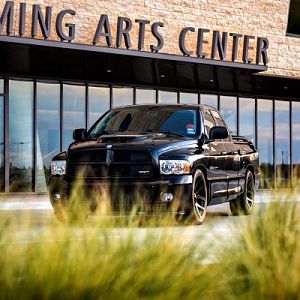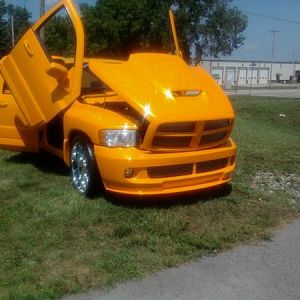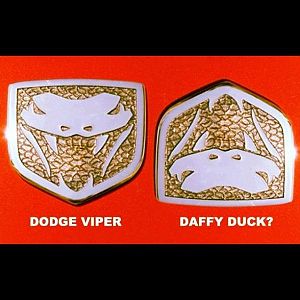94rt10ohio
Full Access Member
2004/2005 Dodge Ram SRT-10 Standard Cab Exhaust Upgrade
Note, 2006 and Ext cab would be similar, possible differences in exhaust hangers.
Parts purchased:
Belanger long tube headers, Jet coated inside and out. Gaskets included. $1899
Belanger catless mid pipes. Clamps included. $450
Roe oxygen sensor sims. $80
Magna Flow Cat Back. Clamps included. $500
Hi-Temp O2 sensor safe silicone. $5
Note, all sockets used were 6 point and all ratchets were 1/2".
1. Disconnect the battery. Tools for this step, 10m wrench.
2. Jack up the truck and secure with 4 jack stands or car ramps. Tools for this step,
Hydralic jack and 4 jack stands or car ramps.
3. Remove all 4 oxygen sensors. The upstream sensors you can leave attached and let them dangle. Unplug the downstream sensors and remove completely. Tools for this
step, 7/8" wrench.
4. Loosen the clamps from both pipes in front of the muffler and on both pipes behind
the muffler. Use a screw driver or something to pry open the clamps once you have the nuts off. The clamps will not come off, but make sure they are open. Tools for this step, 15m deep socket, ratchet, 15m wrench, flat screw driver.
5. Remove the tailpipe from the back of the muffler. Before doing this stuff a towel or
rag between the tail tips and your bumper!! Depending on how fused your pipes are to your muffler you may have to apply some heat. To remove the rubber hangers lube
them with WD-40. You will then be able to slide the rubber off the hangers. There is one at the tip and one on the frame rail. Tools for this step, torch if heat needed, WD-40.
6. Remove muffler from mid pipes. Remove three rubber hangers, two on the frame rail, and one on the inside near the drive shaft. Tools for this step, WD-40 and torch if needed.
7. Remove the mid pipes from the exhaust manifolds, three bolts on each side. This is the most difficult disassembly step, get past this and you are home free. Tools for this step, 13m socket, long extensions and a rachet.
8. Remove the upper heat shield from the exhaust manifolds. Tools for this step, 1/2"
deep socket and ratchet.
9. Remove exhaust manifolds. Tools for this step, 1/2" deep socket, 1/2" socket and ratchet.
10. Make sure there is no gasket is stuck to the head.
11. If you are installing Belanger headers remove the plugs, then remove the heat shields from the spark plug hole. Keep track what plug came out of which cylinder. Tools for this step, Spark plug socket, ratchet and pliers.
Optional, but recommended. Remove the inner front wheel wells and tires. It will make getting the new headers on MUCH easier.
Disassembly is done!!
12. Install new headers. Make sure to torque to specs for your headers, probably around
25/30 ft/lb. You may also have to move the positive battery cable going to the starter.
Also be careful not to cross thread the bolts into the heads. If you have coated headers
clean them once installed BEFORE starting. Tools for this step, 1/2" socket, ratchet and
1/2" wrench. Note, many owners and installers will go a bit higher than the torque specs
but I warn you, do not strip out the heads, they are aluminum. If you want to tighten a little more than spec make sure you are using 1" bolts and not 3/4". Again, be very CAUTIOUS if you do this.
13. Re-install the spark plugs re-attach the plug wires. It is recommended to put the
plugs back into the same cylinders you took them out of. Some put the heat shields back in the spark plug holes, some do not. Some also buy heat sleeves to go over the rubber boot. I recommend the shields or sleeves (I have yet to by my sleeves). Tools for this step, spark plug socket and ratchet.
14. Install upstream oxygen sensors. Tools for this step, 7/8" wrench.
15. Attach mid pipes to the header collector. Belanger recommends no gasket but to use
a oxygen sensor safe hi temp silicone. Some have used gaskets, some silicone, seems both works. Belanger mids are two pieces with a clamp, slide the pieces together, snug the clamp, but leave loose enough to adjust the pipes. You will need to move them a
little later. Tools for this step, 9/16" socket, 9/16" deep socket, ratchet, 9/16" wrench.
16. Attach muffler to mid pipes. You will have to adjust the mid pipes to meet the muffler, this is why you should not tighten the clamps in step 15. Once you have the
muffler on the mid pipes (support the muffler, DO NOT LET IT HANG) attach the two rubber hangers. One on the frame rail and one near the drive shaft, once you have these on you no longer have to support the muffler. Then tighten the clamps on the mid pipes you did not tighten in step 15, then tighten the clamps on the muffler to the mid pipes. Tools for this step, 9/16" deep socket, 15M deep socket, impact, ratchet and WD-40.
17. Attach intermediate tailpipe to muffler. There is one rubber hanger to attach.
Tighten clamps. Tools for this step, 17m deep socket, racket, impact and WD-40.
18. Attach tail pipe to intermediate pipe. There is one rubber hanger at the back of the
truck. Slide the pipe back until you get it sticking out the back where you want it before
tightening the clamps. Tools for this step, 17m deep socket, racket, impact and WD-40.
19. Install Oxygen sensor simulators in place of the downstream sensors. With Roe sims cut the connector off the sensors you took out and crimp onto the sims. Tools for this step, wire cutters, crimpers and electrical tape.
20. Reattach battery. Tool for this step, 10m wrench.
21. Start truck, check for exhaust leaks (tip 2).
22. Lower Truck. Tools for this step, hydralic jack.
23. Start truck and let it warm to temp. Check and make sure you do not have any ignition wires hitting the headers/melting.
24. GO FOR A RIDE!
Tips...
1. The clamps that came with the Magna Flow cat back are very hard to get
tight enough to stop leaks. The mid pipes where they go into the muffler is the hardest to stop leaking. I ended up welding these two pipes.
2. Right after you start for the first time (while still on stands) get under the truck
before it gets hot and see if you can feel air at the clamps, if you do they are not tight
enough or need welded as I mentioned in tip 1.
3. The clamps that came with the mid pipes (they are two piece pipes) also have to be
tightened very hard, that is why I list impact in the tools needed.
4. Do not try to do this in a day, unless you have help. Take your time.
5. It would be much easier with a lift, but the stands and or ramps will work.
6. It will take the computer a couple hundred miles to "tune in". If you want to dyno do
it after a couple hundred miles. Or get a PCM or VEC II and doing some programming.
7. When you start the first time you will get some burning off the pipes, this is normal.
Note, 2006 and Ext cab would be similar, possible differences in exhaust hangers.
Parts purchased:
Belanger long tube headers, Jet coated inside and out. Gaskets included. $1899
Belanger catless mid pipes. Clamps included. $450
Roe oxygen sensor sims. $80
Magna Flow Cat Back. Clamps included. $500
Hi-Temp O2 sensor safe silicone. $5
Note, all sockets used were 6 point and all ratchets were 1/2".
1. Disconnect the battery. Tools for this step, 10m wrench.
2. Jack up the truck and secure with 4 jack stands or car ramps. Tools for this step,
Hydralic jack and 4 jack stands or car ramps.
3. Remove all 4 oxygen sensors. The upstream sensors you can leave attached and let them dangle. Unplug the downstream sensors and remove completely. Tools for this
step, 7/8" wrench.
4. Loosen the clamps from both pipes in front of the muffler and on both pipes behind
the muffler. Use a screw driver or something to pry open the clamps once you have the nuts off. The clamps will not come off, but make sure they are open. Tools for this step, 15m deep socket, ratchet, 15m wrench, flat screw driver.
5. Remove the tailpipe from the back of the muffler. Before doing this stuff a towel or
rag between the tail tips and your bumper!! Depending on how fused your pipes are to your muffler you may have to apply some heat. To remove the rubber hangers lube
them with WD-40. You will then be able to slide the rubber off the hangers. There is one at the tip and one on the frame rail. Tools for this step, torch if heat needed, WD-40.
6. Remove muffler from mid pipes. Remove three rubber hangers, two on the frame rail, and one on the inside near the drive shaft. Tools for this step, WD-40 and torch if needed.
7. Remove the mid pipes from the exhaust manifolds, three bolts on each side. This is the most difficult disassembly step, get past this and you are home free. Tools for this step, 13m socket, long extensions and a rachet.
8. Remove the upper heat shield from the exhaust manifolds. Tools for this step, 1/2"
deep socket and ratchet.
9. Remove exhaust manifolds. Tools for this step, 1/2" deep socket, 1/2" socket and ratchet.
10. Make sure there is no gasket is stuck to the head.
11. If you are installing Belanger headers remove the plugs, then remove the heat shields from the spark plug hole. Keep track what plug came out of which cylinder. Tools for this step, Spark plug socket, ratchet and pliers.
Optional, but recommended. Remove the inner front wheel wells and tires. It will make getting the new headers on MUCH easier.
Disassembly is done!!
12. Install new headers. Make sure to torque to specs for your headers, probably around
25/30 ft/lb. You may also have to move the positive battery cable going to the starter.
Also be careful not to cross thread the bolts into the heads. If you have coated headers
clean them once installed BEFORE starting. Tools for this step, 1/2" socket, ratchet and
1/2" wrench. Note, many owners and installers will go a bit higher than the torque specs
but I warn you, do not strip out the heads, they are aluminum. If you want to tighten a little more than spec make sure you are using 1" bolts and not 3/4". Again, be very CAUTIOUS if you do this.
13. Re-install the spark plugs re-attach the plug wires. It is recommended to put the
plugs back into the same cylinders you took them out of. Some put the heat shields back in the spark plug holes, some do not. Some also buy heat sleeves to go over the rubber boot. I recommend the shields or sleeves (I have yet to by my sleeves). Tools for this step, spark plug socket and ratchet.
14. Install upstream oxygen sensors. Tools for this step, 7/8" wrench.
15. Attach mid pipes to the header collector. Belanger recommends no gasket but to use
a oxygen sensor safe hi temp silicone. Some have used gaskets, some silicone, seems both works. Belanger mids are two pieces with a clamp, slide the pieces together, snug the clamp, but leave loose enough to adjust the pipes. You will need to move them a
little later. Tools for this step, 9/16" socket, 9/16" deep socket, ratchet, 9/16" wrench.
16. Attach muffler to mid pipes. You will have to adjust the mid pipes to meet the muffler, this is why you should not tighten the clamps in step 15. Once you have the
muffler on the mid pipes (support the muffler, DO NOT LET IT HANG) attach the two rubber hangers. One on the frame rail and one near the drive shaft, once you have these on you no longer have to support the muffler. Then tighten the clamps on the mid pipes you did not tighten in step 15, then tighten the clamps on the muffler to the mid pipes. Tools for this step, 9/16" deep socket, 15M deep socket, impact, ratchet and WD-40.
17. Attach intermediate tailpipe to muffler. There is one rubber hanger to attach.
Tighten clamps. Tools for this step, 17m deep socket, racket, impact and WD-40.
18. Attach tail pipe to intermediate pipe. There is one rubber hanger at the back of the
truck. Slide the pipe back until you get it sticking out the back where you want it before
tightening the clamps. Tools for this step, 17m deep socket, racket, impact and WD-40.
19. Install Oxygen sensor simulators in place of the downstream sensors. With Roe sims cut the connector off the sensors you took out and crimp onto the sims. Tools for this step, wire cutters, crimpers and electrical tape.
20. Reattach battery. Tool for this step, 10m wrench.
21. Start truck, check for exhaust leaks (tip 2).
22. Lower Truck. Tools for this step, hydralic jack.
23. Start truck and let it warm to temp. Check and make sure you do not have any ignition wires hitting the headers/melting.
24. GO FOR A RIDE!
Tips...
1. The clamps that came with the Magna Flow cat back are very hard to get
tight enough to stop leaks. The mid pipes where they go into the muffler is the hardest to stop leaking. I ended up welding these two pipes.
2. Right after you start for the first time (while still on stands) get under the truck
before it gets hot and see if you can feel air at the clamps, if you do they are not tight
enough or need welded as I mentioned in tip 1.
3. The clamps that came with the mid pipes (they are two piece pipes) also have to be
tightened very hard, that is why I list impact in the tools needed.
4. Do not try to do this in a day, unless you have help. Take your time.
5. It would be much easier with a lift, but the stands and or ramps will work.
6. It will take the computer a couple hundred miles to "tune in". If you want to dyno do
it after a couple hundred miles. Or get a PCM or VEC II and doing some programming.
7. When you start the first time you will get some burning off the pipes, this is normal.
Attachments
-
 092406.4.jpg174.7 KB · Views: 206
092406.4.jpg174.7 KB · Views: 206 -
 092406.5.jpg147.2 KB · Views: 170
092406.5.jpg147.2 KB · Views: 170 -
 092406.2.jpg162.5 KB · Views: 185
092406.2.jpg162.5 KB · Views: 185 -
 092406.1.jpg167 KB · Views: 177
092406.1.jpg167 KB · Views: 177 -
 092406.3.jpg139.7 KB · Views: 205
092406.3.jpg139.7 KB · Views: 205 -
 093006.1.jpg176.6 KB · Views: 315
093006.1.jpg176.6 KB · Views: 315 -
 093006.2.jpg153.8 KB · Views: 239
093006.2.jpg153.8 KB · Views: 239 -
 093006.3.jpg158.2 KB · Views: 265
093006.3.jpg158.2 KB · Views: 265 -
 093006.5.jpg128.5 KB · Views: 206
093006.5.jpg128.5 KB · Views: 206 -
 093006.6.jpg79.1 KB · Views: 223
093006.6.jpg79.1 KB · Views: 223 -
 093006.4.jpg144.1 KB · Views: 238
093006.4.jpg144.1 KB · Views: 238
Last edited:





